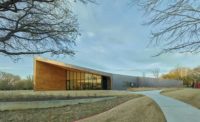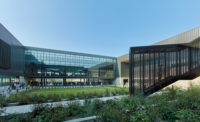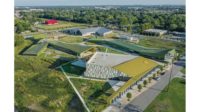Marlon Blackwell is not afraid to create a little tension. On the second floor of his new renovation and expansion of the architecture school at the University of Arkansas, which opened this fall, students file through a tall, narrow doorway as they make their way between a grand Beaux Arts–style salon into a contemporary addition. The threshold, lined with razor-thin steel panels, slices through the older interior's wall and decorative molding as if surgically inserted into the room, a move as deft as it is abrupt. Overhead, a light well, painted bright red, terminates in a rectangular oculus, introducing color and a fine-edged geometry into the white, austerely classical space. “The new and the old start to infect each other,” says Blackwell. “But rather than resolving the two, we wanted the building to resonate, to vibrate like a tuning fork.”
Since the 1970s, the Fay Jones School of Architecture—named for the revered regionalist who taught there throughout his career—inhabited the Beaux Arts building, originally constructed in 1934 as a library. It occupies a prominent site along the primary axis through campus, positioned just behind Old Main, an august mansard-roofed 1878 building. But the former library had never been fully fitted out as an architecture school; ad hoc studios were stuffed into reading rooms, and first-year students were banished to flood-prone basement work spaces. Three years ago, the Donald W. Reynolds Foundation offered a $10 million grant toward a comprehensive upgrade and addition to the building, but it required the school to submit initial plans within weeks. Lacking time to put out a request for proposals, then-dean Jeff Shannon convinced the university’s chancellor to hire Blackwell, who has taught at the architecture school for more than two decades and currently chairs the department. The move allowed the school to meet the deadline, but it rankled other Arkansas architects, as well as alums who wanted a shot at the commission.
Unperturbed, Blackwell and his firm delivered a minimalist renovation of the former library building and appended a four-story 35,000-square-foot addition. The new rectangular volume, a post-tensioned concrete structure mostly clad in limestone and zinc panels, with one fully glazed facade, stands behind the Beaux Arts library, turning the older building’s T-shaped plan into an H. The combined facility contains new studio, classroom, and administrative spaces, as well as model shops, a gallery, a roof terrace, and a 200-seat auditorium. The project, which currently accommodates 480 students, also consolidates the architecture, landscape, and interior design departments under one roof.
The overall design allows the old building and the new wing to express their distinct architectural languages and building methods, but it stitches them together in key places to create moments of frisson. Blackwell envisions the hybrid structure as a teaching tool. “You have walls, columns, different load-bearing conditions, and cantilevers,” he says. “It’s not like the Pompidou, where the building just throws up its skirt, but you have this encyclopedia or this whole reference guide to architecture.”
The text begins in the former library, where the firm’s renovation distills and augments Beaux Arts details. The architects stripped decades of muddy ochre pigment from the walls and repainted the plaster a bright white, which highlights wood doorways and emphasizes the scale of the rooms, an effect heightened by dark cork flooring.
While the circulation through the library building once dead-ended in four floors of book stacks, it now continues through the addition, where the architectural vocabulary switches abruptly to emphasize structure and hard-working materials. Twin stairs, enclosed in glass shafts with steel frames that curve into benches, rise along the joint between the old and new sides of the building. They connect basement-level workshops and computer labs to the ground floor—which houses a student lounge, administrative offices, and a gallery—and to the upper levels where studio spaces and classrooms show off the addition’s handsome poured-in-place concrete structure. (One complaint that several students echoed on a recent visit was about the acoustics in some of the new classrooms.)
The addition’s glass facade contrasts dramatically with the inward-looking, temple-like library. “The west side is really one big window,” says Blackwell. The custom double-skin glazing system uses vertical fritted glass fins to filter sunlight. While it provides ample daylighting for classrooms and work spaces, the system also turns the building into a lantern, projecting indoor activities outward to the campus when the sun goes down, and—this being architecture school—the effect typically lasts late into the night.
That presence has given the architecture school a higher profile within the university, or as Kyle Marsh, a fourth-year student, put it on a recent afternoon, “The contemporary building in the old part of campus reflects the kind of work being done inside.” He makes an important point. With an open call for proposals, the administration could have chosen a design architect from anywhere in the world. Instead, they selected someone deeply familiar with the architecture school, who could tailor the addition to both the campus and the teaching program. “I don’t know what the overall grand message to the students is,” says Blackwell, “but I hope the project underscores what it is to build well.”
PeopleFormal name of building: Location: Address: Completion Date: Gross square footage: Total construction cost: Owner: Architect's firm: Personnel in architect's firm who should receive special credit: MBA Project Team: Polk Stanley Wilcox Architects ' Associate Architect Mark Herrmann AIA, Associate Principal in Charge and Project Manager PSW Project Team: Architect of Record and Design Architect: Associate Architect: Interior design: General contractor: Structural Engineer: Mechanical, Electrical, Plumbing, Fire Protection Engineer: Civil Engineer: Landscape Architect: Lighting Designer: Geotechnical Consultant: Preservation Consultant: Concrete Consultant: Acoustics and Daylighting Consultant: LEED Project Team: Curtain Wall Consultant: Accessibility Consultant: Construction Document Coordination Review Consultants: General contractor: Photographer: Renderer: CAD system, project management, or other software used: Size: 90,955 square feet Cost: $32.4 million Completion date: August 2013 |
ProductsStructural system and steel frame with composite decking: Other Concrete work: Concrete supplier: Exterior cladding Architectural Precast Concrete: Stone and Masonry Restoration: Metal Panels: Rheinzink Metal / glass curtain wall: Other Curtain Wall: Kawneer Architectural Metals and custom fire stairs: Precast concrete: Engineered Glass Railing System: Moisture barrier: Typar Roofing Tile/shingles: Certain Teed Roofing Green Roof: LiveRoof Roof Composite Decking: Cali Bamboo Windows Custom Metal frame and fixed glass windows: Curtain wall systems: Kawneer Glazing Skylights (custom non-standard large size, insulated and tempered): Fritted Glass at custom fabricated curtain wall: Other: Red color glass: Tristar Doors Entrance Mats: Mats Inc. Metal doors: Stiles Custom Metal, Inc Wood doors: VT Industries Aluminum door frames: Raco Interior Products Glass doors: Oldcastle BuildingEnvelope Hardware Closers: LCN Exit devices: Pulls: Rockwood Security devices: Interior finishes Custom Felt ceilings and walls: Plaster restoration: Gypsum board ceiling: Restroom partitions: Restroom Specialties: Paints and stains: Wall coverings: Acoustic Paneling: All Millwork: Plastic laminate: Quartz and solid surfacing: Special surfacing: Floor and wall tile Iris US (restrooms floors and accent walls), American Olean (ceramic wall tiles, at restrooms). Glass Tile store.com (glass tiles at walls of shower locations) Resilient flooring: Carpet: Terrazzo Flooring: Raised flooring: Special interior finishes unique to this project: Furnishings Reception, staff and faculty Lounges furniture: Classroom Furniture: Conference rooms tables and staff Lounge tables: Whiteboard at classrooms: Upholstery: Outdoor Furniture: at roof terrace: Windowshade: Other furniture: Custom Studio Desk frames by Razorback Ironworks, woodworks by Estes Wood Design, finishes by Burnet paint, custom LED lighting by Malstrom Lighting. Wood Tableau from fallen red oaks at site by Fletcher Cox. Lighting Exterior: Dimming System or other lighting controls: Conveyance Plumbing (all fixtures are water saving types due to this being a LEED project) Energy Other unique products that contribute to sustainability: Add any additional building components or special equipment that made a significant contribution to this project: |

















